Coffee Grinder Burr Size – Bigger Is Better?
by Jeanette Kierstead
When you are investing your hard-earned money in coffee-making equipment, you need to know that you’re getting the best coffee gear possible.
Here at Know Your Grinder, we always talk about how grinding the beans yourself is a crucial step towards better coffee, if you do it correctly. Burr coffee grinders, in particular, are necessary to getting the job done right.
Before we dive into the topic of burr grinders, let’s ask this: why is grinding so important in the first place?
Watch this video, which explains why the grinding part of the coffee-making process is so important, courtesy of our friends at America’s Test Kitchen.
As this video mentions, you should always keep in mind the brewing method you’ll be using when you grind your beans. Will you be using a French Press? Drip coffee maker? High end espresso machine? You need to know this, so that you can grind your beans to the appropriate grind size. If the grind size does not suit the brewing method, or if it is inconsistent, you’ll end up with coffee that does’t taste quite right.
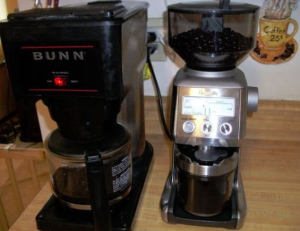
In case you didn’t know, there’s two types of coffee grinders – blade grinders, and burr grinders.
There is a wide spectrum of how these actually look, but inside the grinder itself, you’ll either find a set of grinding burrs, or blades.
Now, burr grinders are the grinder of choice by anyone who really cares about the taste of their coffee.
This leads us to the topic we really wanted to focus on today, which is that of burr size.
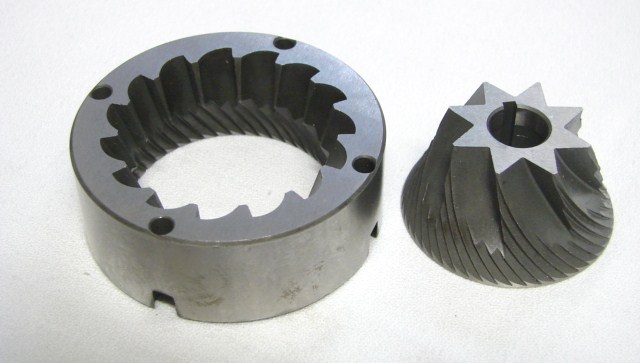
The question is – are bigger burrs better when it comes to producing better coffee?
Or, to put it another way, can we get the same quality of coffee grinds from a grinder with smaller burrs? What about a small grinder with big burrs – is there such a contraption?
Ok, that’s enough questions. Now how about some answers!
Which Grinders Have Burrs?
To clarify, grinding burrs can be found in all sorts of coffee grinders. From manual coffee grinders under $50, to high end commercial electric coffee grinders over $2000, burrs of different sizes and materials can be found in a wide range of coffee grinders. That said, there is a correlation between the size of the burrs and the quality of the end result – the coffee!
Baratza Encore
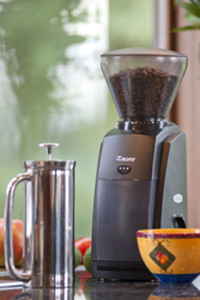
For example, let’s take a look at a burr grinder that is an excellent home model of coffee grinder which is the Baratza Encore.
In the overall spectrum of coffee grinders on the market, let’s call the Baratza Encore a “mid-priced” model, costing at least a couple hundred dollars (depending where you buy). As we said, prices for coffee grinders can range from $15 to thousands upon thousands of dollars, so that’s why we call it mid-priced.
Baratza Encore Burr Size
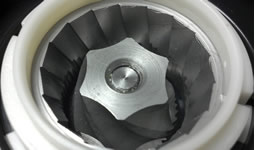
Equipped with steel 40 mm conical steel burrs, this is one of the main selling points of the Baratza Encore and the burrs contribute greatly to its level of performance when it comes to grinding for different brewing methods.
Take note again of the size of burr set – they are 40 mm in size and conical in shape, and made from solid steel.
As we know with many products on the market, manufacturers often cut corners by substituting what could be high quality parts with lower quality parts. Not to say this is the case with the Encore, but to illustrate our point here, let’s imagine Baratza were to increase the burr size of the Encore to a slightly larger 50 mm burr set. What would happen? Could this be done and would this improve the product?
With the Encore, the fact is the entire machine is designed for the burr size that it already has – 40 mm. It is designed like this for a reason. For the price and performance you get with the Baratza Encore, 40 mm steel conical burrs work just fine.
Take a look at this Baratza Encore in action, to see what a 40 mm burr coffee grinder is capable of.
If our opinion of the Baratza Encore is any indication (not to mention what customers have said, and other coffee specialists), 40 mm is a burr size which can accomplish a lot – particular when its a conical burr set.
…but what if we go bigger?

Have a look at the grinder on the left here, the famous Rancilio Rocky, one of our absolute favourites, and a slightly more costly model than the Encore by a few bucks.
Consider this: the Rocky has 50 mm burrs. According to Rancilio, these are “commercial grade grinding burrs”. Sounds fairly serious, right? Does this mean you could buy a Rocky for your coffee shop and put this grinder to work, instead of buying it simply for home use? According to the manufacturer, yes.
If you want to know what we think qualifies as a great coffee grinder that’s made to use in a café or restaurant environment, read this article of ours right here.
In any case, all things considered, we do think that the Rancilio Rocky is a step up from the Baratza Encore, and it also has bigger coffee grinder burrs. Well, well. Coincidence?
Yes, we do think that the Rocky is more versatile than the Encore, and we think most coffee snobs would agree with us.
After all, you do get what you pay for and the Rocky is just fancier. But, technically, how much of this grinding versatility is owed to the size of the coffee grinder burrs it has?

Let’s put it this way. The flavour of your cup of coffee is controlled by a number of factors, including:
- Where your beans originate from
- Their flavor profile of the beans
- How fresh they are when you brew with them
- Grind consistency
- The brewing method you use
- The quality of the water you use to make your coffee
…and the list goes on!
Burr Versatility
Its no secret in the coffee community that burr grinders beat blade grinders hands down. When it comes to burr grinders, there are basically four factors that really determine the outcome of your coffee:
- Burr Adjustability (Stepped Vs. Stepless)
- Burr Shape (Conical Vs. Flat Burrs)
- Burr Material (Steel Vs. Ceramics)
- Burr Size
Ah, so the plot thickens…!
First we were just looking at burr size, and now we’ve thrown in three more factors to confuse matters. Luckily, there is a way to round everything up here without too much hassle. To explain…
#1 – Burr Adjustability

Burr grinders are usually adjustable to some extent, meaning you can bring the burrs closer together or take them apart if you want a finer or coarser grind. This can usually be done quickly with more expensive grinders that possess this feature, and doesn’t require any extra fiddling around (although it does sometimes with some hand grinders).
If a grinder is “stepped”, it means these micro-adjustments are incremental. In other words, you can set your grinder to “20” and know that this is how the burrs need to be set in order to grind for a particular brewing method.
The correlation between adjustability and burr size here is that bigger burr sets (one top burr, one bottom burr = 1 burr set) usually allow for more micro-adjustments.
Some grinders have many “steps”, while some grinders are “stepless”, which means the burrs do not adjust incrementally, and hence make their adjustments “infinite”.
Stepless grinders usually have larger burrs, as do “stepped” grinders with a wide adjustment range.
#2 – Burr Shape
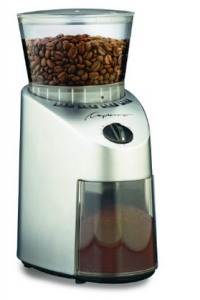
Burrs can either be flat in shape or conical (cone-like). To describe the difference briefly, flat burrs use a totally different kind of force to grind coffee beans (centrifugal) than conical burrs (gravity).
Is one shape better than the other? In our view, conical burrs are always better than flat burrs because they use gravity (the beans slowly tumble in), and this requires less energy to be expended on the part of the grinder.
Less energy for the grinding means that there’s less heat and less heat is always better for grinding. A cool grind is always preferred, because too much heat transfer can adversely affect the flavour of the coffee.
The fact that conical burr grinders use gravity as the dominant grinding force does no indicate a lack of power on the part of the grinder itself (if the grinder is electrical, that is). It simply means the physics acting on the beans are different from flat burrs.
The correlation between shape and burr size is that you can find both flat and conical shaped burrs in all types of grinder, from small manual models to high end electric models. Our preference is usually for conical burr grinders, regardless of the size or purported power of the unit. However, with that said, when grinders get beyond a certain size, you won’t be seeing any that have extremely big burrs that are conical. Most of the grinders with the biggest burrs are flat-burr grinders.
Here’s a video showing the two different burr grinder shapes you’ll come across – flat and conical.
#3 – Burr Material
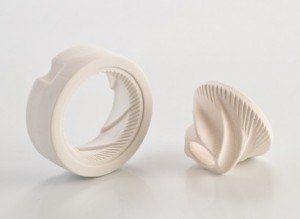
Burrs are usually made of one of two materials – steel, or ceramics. There is a difference in these two types of material, but that is a discussion for another article (and here it is). What we will say here is that we do like ceramic burrs better, because they don’t conduct as much heat and they are extremely durable.
To relate this to burr size, the fact is that you will find burrs of different sizes that are made of both steel or ceramic materials, although ceramic burrs are always found to be conical in shape, in our experience.
Ok, now back to factor #4 – burr size.

We’ve given so far of two coffee grinders – the Baratza Encore with its 40 mm conical burrs, and the Rancilio Rocky with its 50 mm plate grinding burrs.
Now, we shall talk about another grinder which has even bigger burrs. Namely, the Mazzer Mini Espresso Grinder, which has 58 mm grinding burrs.
Mazzer, one of the great names in the world of coffee grinders, sells several of the best burr grinders on the market, and most of them are meant for commercial use. The Mini, however, is aimed at home users. Despite being called the “Mini”, it’s got some large burrs.
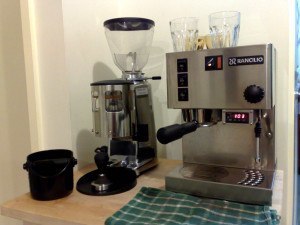
The Mazzer Mini is a stepless grinder with flat steel burrs. As we said before, we do prefer conical burrs if we had to choose one type of burr over the other, but the fact that the Mazzer Mini is a flat burr grinder does not detract from the excellence of this machine.
It is no coincidence that the Mazzer Mini is used in both home and commercial settings. It has a large grinding capacity, and can keep up with the demands of a café environment which means grinding large quantities of beans on a regular basis. This could not be done without the large-sized 58 mm burrs the Mazzer Mini has. The point here being that there is a definite relationship (if you haven’t noticed by now) between big burrs and big, powerful coffee grinders.
Bigger Burrs = Commercial Coffee Grinder?
Although Mazzer is not the only company to make larger, commercial use coffee grinders (Mahlkonig also springs to mind), they are one of the best known. Mazzer specializes in making commercial grade grinders, and the Mini is one of the few that straddles the line of being both a home use grinder and a commercial use model. From there, they only get bigger.
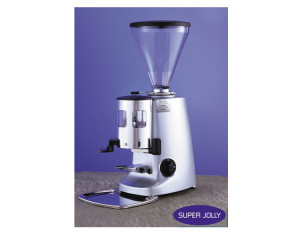
A popular commercial use grinder by Mazzer is the curiously named Super Jolly, which sports 64 mm flat steel burrs.
It is unlikely you will encounter a Super Jolly in someone’s home. It is made to grind large quantities of beans with exacting precision. To do what it does, the Mazzer Super Jolly relies on its formidable hardware. Basically, everything about this grinder is plus-sized, including the burrs.
Burr Size – Bigger Does Mean Better
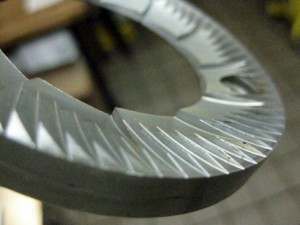
Ok, we’ve laid out quite a few examples to show this, and now we’re just going to out and out say it. Bigger burrs usually does mean better burrs. Yes, its true.
We don’t want to say *always*, because there are always exceptions to the rule. However, in general, it is a fact.
So, let us make it very clear what powers bigger burrs will grant us.
Speed & Efficiency
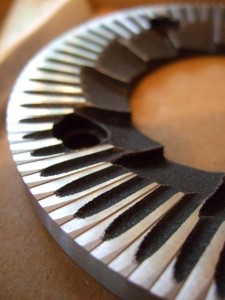
Since the rule is that the bigger the burrs, the bigger the grinder, it should be obvious that bigger grinders can usually get the job done faster. When burrs spin, we measure that in RPMs, powered by the grinder’s motor.
Most grinders give you these stats upfront, stating exactly the amount of coffee grinds it can product in X amount of time. Usually, the size of the burrs are mentioned in the same breath as well as their shape and material.
Bigger Burrs = More Power = Less Noise
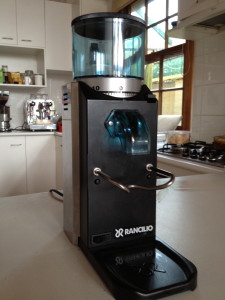
This goes along with the previous point, but there’s a slight difference. Yes, bigger burrs can get the job done faster, and this requires a more powerful motor. When this is the case, not only does the job get done faster, it gets done quieter. This is another well-advertised feature of higher-end grinders, because no one likes a loud, obnoxious grinder.
For instance, with its 50 mm burrs the Rancilio Rocky spins them quickly at 1725 RPMs, and it is also known for doing so with relative ease. One of the reasons the Rocky gets a lot of favourable reviews is not only due to the consistency and quality of the grinds it produces, but it has the added feature of not being super loud. This is always appreciated, especially in your home where coffee is often made early in the morning and a noisy grinder can result in waking up grumpy people. Hence, there is a preference for grinders like the Rocky.
Control / Adjustability
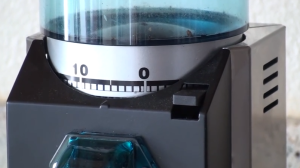
The Rancilio Rocky offers 50 stepped micro-adjustments
As we mentioned earlier, burr grinders control the distance between the two burrs using incremental micro-adjustments (stepped adjustment) or an infinite range (stepless adjustment).
The Rancilio Rocky is a stepped grinder with 50 mm burrs, and offers up to 50 individual grind settings to allow you to be very specific with your grind coarseness or fineness. Since it is more of a higher end home unit, it does offer this feature of micro-adjustments, which home users find handy.
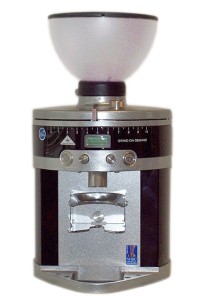
Bigger burrs, overall, means you get more control over your grinding range. A larger grinding range means more possibilities when it comes to brewing.
When you get into the largest of the commercial units, like some of the Mahlkonig models, you might expect it to be stepless, or have a huge grind range, but this isn’t always the case.
With the Mahlkonig 30, it isn’t all about having those 1001 grinding increments. Rather, it has other features that we haven’t even touched upon in this article that make it world class. After all, World Champion baristas choose Mahlkönig as their grinder of choice.
Easy To Clean
With regards to cleaning, burr grinders do require maintenance to keep them in tip top form. With bigger burrs, you have the distinct advantage over smaller units of having an easier time cleaning your coffee grinder.
This is almost too obvious to point out, but the bigger you grinder is (including its internals), the easier it is to “get at” all the bits and pieces as they are simply larger. This goes for burrs too, of course. It is easier to see any particles that might be jamming up the works, etc.
R.O.I.
If you’ve followed along this far, all we can say is wow, you really must care about your coffee!
Of course, there is a good chance that if you are reading this, you may be more invested in coffee than your average coffee drinker. In other words, maybe you’re running a business and you need to know the nitty gritty details about grinders, which is understandable. Your business may depend on this information.
As it happens, there are many, many benefits to coffee grinder with bigger burrs that ultimately add up to a better cup of coffee or espresso. Bigger burrs usually indicate a bigger, better machine, and those are usually made for the long haul, as in decades of service as opposed to months or even a few years.

Maybe you don’t need a grinder with gigantic burrs, if you are a home user. That’s quite alright, as there are plenty of burr coffee grinders that are mid-priced that are great for both home and commercial use. If you are specifically looking at getting a commercial coffee grinder, check out this article right here that looks at some of the higher end models cafés and restaurants often get.
The bottom line is that yes, bigger is most often better when it comes to burrs to you’ll want to familiarize yourself with those models if you are a serious coffee drinker. It can be a serious purchase, but it will definitely pay you back in more ways than one!
 |
 |
 |
 |

About Jeanette Kierstead
Jeanette has been testing and reviewing kitchen appliances for over six years now, so she knows her stuff when it comes to finding the best ones. In her spare time, she loves nothing more than baking cakes and cookies – especially if she can do so with one of her favorite stand mixers! When she's not in the kitchen, Jeanette is usually looking after everything homes-related; from garden tools to smart home products.
Thoughts on "Coffee Grinder Burr Size – Bigger Is Better?"
 |
 |
 |
 |
Get FREE Coffee Gifts now. Or latest free grinders from our best collections.
Disable Ad block to get all the secrets. Once done, hit any button below
 |
 |
 |
 |